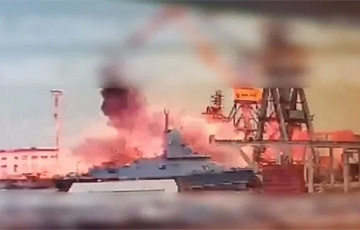Forbes: Ukrainian Missiles Are Blowing Up The Black Sea Fleet’s New Missile Corvettes Faster Than Russia Can Build Them
- 22.05.2024, 12:22
- 4,302

The Ukrainian Armed Forces have created an excellent arsenal of means for this.
The Russian navy missile corvette Tsyklon entered service with the Black Sea Fleet in July 2023, and already on May 19 a Ukrainian strike sank the 220-foot Karakurt-class vessel in Sevastopol. Another Karakurt, the incomplete Askold, was damaged in a November Ukrainian missile raid on a shipyard in Kerch in Crimea.
“Russian navy officials should be very worried about the future of the Black Sea Fleet. Ukraine is taking out the fleet’s warships faster than Russia can build or reinforce them with ships from other regional fleets,” writes Forbes.
As long as Turkey blocks warships from passing through the Bosporus Strait connecting the Mediterranean Sea to the Black Sea, the only way for the Russians to reinforce the shrinking Black Sea Fleet is to transfer smaller vessels to the Black Sea by river—or to build them in Black Sea shipyards.
It’s not for no reason that, in April, Ukrainian commandos sabotaged the Russian missile corvette Serpukhov in Kaliningrad on the Baltic Sea. The Buyan-class corvette was one of the few Russian warships small enough to travel to the Black Sea via canals, the Volga River, the Don River and then the Sea of Azov.
In addition to the damaged Askold and the wrecked Tsyklon, five more Karakurts are under construction at shipyards in Crimea or on the Volga River, which connects to the Black Sea by way of the Don River. There’s every reason to expect those corvettes will also come under attack as they join the fleet in the near future, the publication writes.
After all, the Ukrainians have been developing—or acquiring from their foreign allies—an array of long-range anti-ship munitions.
They’ve got locally made aerial drones and drone boats. In addition, they’ve got Neptune ground-launched cruise missiles. Apart from that, the United Kingdom and France have given Ukraine Storm Shadow and SCALP-EG air-launched cruise missiles that travel as far as 155 miles; the United States has donated several models of ground-launched Army Tactical Missile Systems rockets, seemingly including 170-mile M48 or 190-mile M57 models with 470-pound warheads and enough accuracy to hit ships in port.
The latest Sunday raid that sank Tsyklon and reportedly also blew up a Black Sea Fleet minesweeper apparently involved a barrage of M48s or M57s. Ukraine has received more than 120 ATACMS in two batches — one last fall, another in April — and has aimed the inertially guided missiles at Russian air bases, air defense installations, training grounds and now naval bases.
“Russian air defenses have been powerless to stop the incoming ATACMS. That’s an ominous development for Russian navy commanders who are struggling to preserve what’s left of the Black Sea Fleet,” the publication notes.
“If ATACMS are taking out Russian warships in Sevastopol, it is hard to see the base having much utility left for the Russians,” pointed out Phillips O’Brien, a professor of strategic studies at the University of St. Andrews in Scotland. Russian commanders may have no choice but to withdraw all surviving vessels to ports in southern Russia that are beyond the range of Ukraine’s ATACMS.
“However, those ports are still within range of Ukraine’s aerial drones, however—so they’re not exactly safe. But compared to ATACMS, drones are easy targets for Russian air defenses. What remains of the Black Sea Fleet might last a little longer against the drones than it would against the ATACMS,” Forbes underlines.










